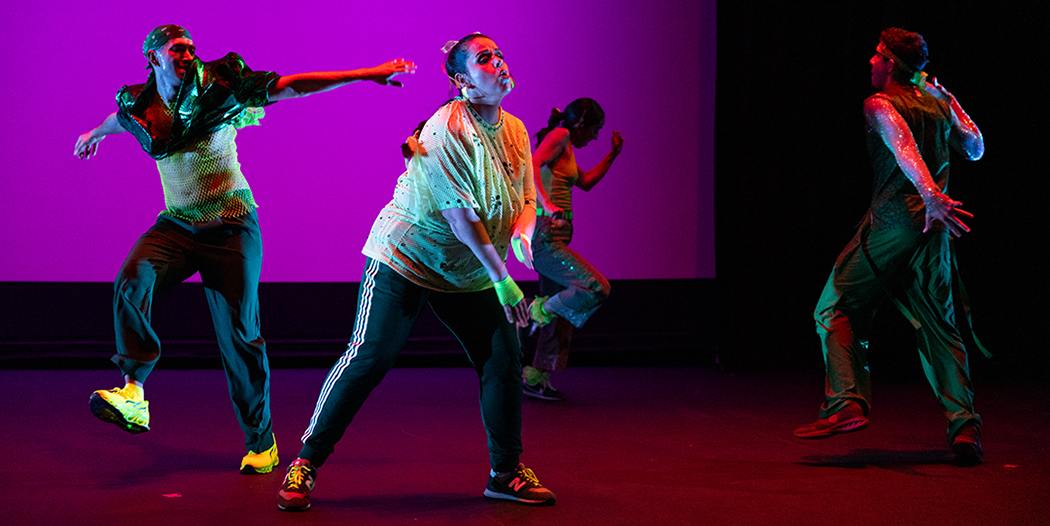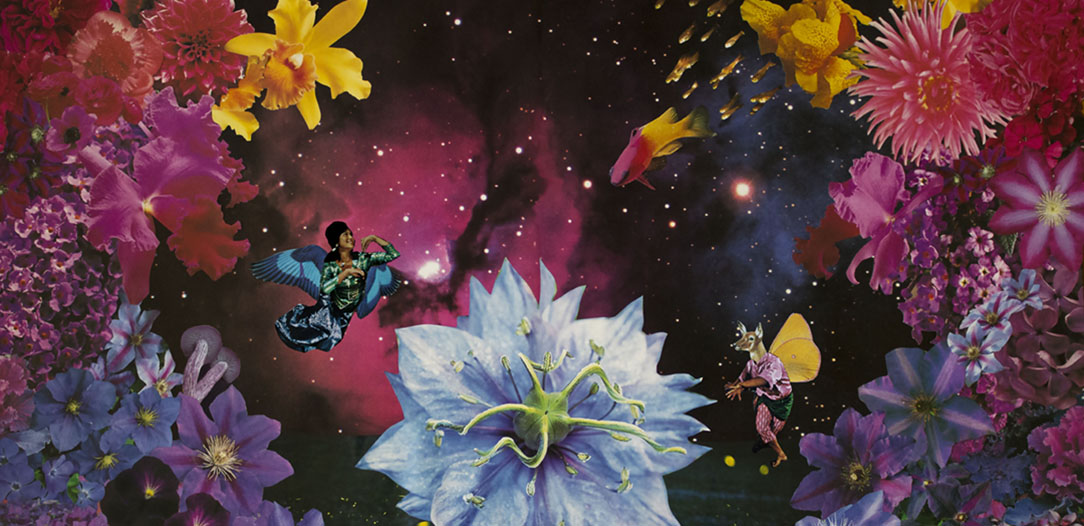
Photo by Ian Douglas
Shape Shifting: A conversation with Dana Michel about Yellow Towel with Rob Avila
Yellow Towel, the much lauded solo by Montreal-based choreographer-performer Dana Michel, makes its San Francisco debut this weekend. Riffing on a blurred range of black stereotypes, the piece has the effect of unsettling the specific in favor of an investigation of the condition of otherness—a two-way street in which the audience can find itself squirming under the burden of its reflex assumptions and interpretations. But the generous nature of the piece comes out in its rigorous hold on the material; a deep excavation that eschews the comforting certainties of character or narrative to give space and time for our own emotional, psychological, social baggage, which itself becomes an object for quiet scrutiny.
Dana Michel recently spoke about the origins and her evolving relation to Yellow Towel by Skype from Toronto.
You first premiered this piece at American Realness in New York in January 2014. The next time you performed it in the U.S. (at the Time-Based Arts festival in Portland in mid-September 2015), much had happened with respect to public consciousness and discourse around American racism and the systemic violence against black and brown bodies. Michael Brown, Eric Garner, Tamir Rice, Sandra Bland, Freddie Gray, Ferguson, Black Lives Matter—these are just a few names in a long list marking this period. While not wanting to be reductive about the work, it is so charged with the history and ongoing pathology of racism that I wonder what it has been like performing it for American audiences through this particular period?
Dana Michel: For sure things have shifted quite a bit since the first time I did this piece in the States, in New York. The feeling in the room [in Portland] was very, very different. This can be geographical; for sure time-based; this is also, I’m assuming, the momentum that the work has gathered in the past couple of years. So there are these factors. And another immediate feeling that I have, I’ll just say: I didn’t have any kind of political agenda when I made the work. Not a conscious one. I would say that the political leanings were quite subterranean if there were any. And so, coming to do the work in the States, I was perhaps naive. I mean, I knew the kind of heaviness, the weight that can be associated with the work, but I wasn’t prepared. I was still quite taken aback by some of the feedback, by the kind of attention that would be paid. Only then I thought, “Ah! I am now starting to understand what the work has undertaken,” which I was not completely conscious of when I made it and when I arrived in Portland. I’m still quite wrapped up in thinking about it. Also, I just opened a new piece last night here (I’m in Toronto right now). So I’m having similar conversations. I make these things intuitively, coming from all different directions, and it’s in the response that I start to map out the potential for what I’ve done, where the work is landing. It’s a very wild and somewhat loaded feeling that I have, coming to propose this work. I take all of the feedback I receive, and this is really important to me. I see where it fits within the work, or within me. But, also, what is very important for me in doing this work is just to create space and not to take on any particular narrative or standpoint.
The title of the piece refers to a childhood practice of using a towel as a blond wig. I understand it comes from a poem you wrote?
Dana Michel: Basically, I was taking a workshop and one of the exercises was to write a poem. [The workshop leader, artist Ivo Dimchev] is very keen on writing poetry just for some sort of making process. So the poem that I wrote was a small, ridiculous poem about my hair. And I named it Yellow Towel.
Was this the germinating seed of the piece or was it more than one thing?
Dana Michel: It was definitely more than one thing. I think probably the very first step was I had taken a leave of absence from my job maybe a year before starting to work on Yellow Towel. I was sitting around trying to come up with how to make money, how am I going to do this? I said, “Ah, I love children. I should make a children’s show!” So I started trying to hatch a plan to make a children’s show. I thought, “I’m going to make a show about a half-Japanese half-Jamaican princess who is trying to understand her components.” Basically, I was just thinking a lot about my nieces and nephews, who are biracial, and who have very fair skin and very coarse hair. Often I sit with them and wonder about how it is that they navigate through the world. Not that any of us have super precise definitions of who we are. But I can sit here and say, I’m black. And this has a certain clarity. Not to say that “I am biracial” doesn’t, but there’s an obvious layer of something. And it’s something.”
A layer of uncertainty or ambiguity? A certain slipperiness?
Dana Michel: Yeah, exactly, it’s a slipperiness.
Yellow Towel began to emerge during a workshop you took with the great Bulgarian-born choreographer and performer Ivo Dimchev at ImPulsTanz in Vienna. Can you describe a little of that process? While audiences are inclined to bring meanings and interpretations to every facet of the composition—the all-white surfaces and objects, for example, against which you the performer or starkly set off—the choices made along the way may have had a variety of motivations.
Dana Michel: Sure, I acknowledge subconscious decisions that drove me to all sorts of different choices. But surface-wise… Well, first of all, in Ivo’s workshop—this is a big one—he had these horse stable-like cabins made for each of us. I think we were fifteen people in the workshop. He had them constructed in order to give us our own studio space, a private booth out of white muslin. So we were each in a ten-by-ten-foot box, in these white psychiatric units. [laughs] That’s where I started making this work, inside of this box. When the first festival that produced the piece was asking, “What is your scenography?” the first logical thing was to just reproduce this kind of environment that I was in when I started to make it. So this is where the white floor and the white curtains came from. There’s also the fact that I’m OCD and I compulsively color group. So once I’ve started with a color then I just compulsively continue. It helps to smooth things out in my brain.
In what ways are you relating to Yellow Towel these days?
Dana Michel: I’m having a thought about when I made the piece. The premiere was in 2013 [in Montreal]. The first time I did it again was in New York in January 2014. I remember trying to look at it again. It was crazy. I thought I can’t possibly do this again. I made this situation; I lived in it; it’s over. I don’t understand how to do it again. It seems not something to rehearse. It just didn’t make any sense. Then it happened. And I said, “Ah, yes. It’s breathing!” It’s a kind of organism, and of course I can live in it again because there are a trillion things that are shifting all the time. Now I’m in a place where absolutely every time I do it a hundred new doors open. There are still all kinds of journeys to go on. Every time I come out of it I’m in a different place, I’m having a different reaction. Of course, again, different audiences, different cities, different times—yeah, it’s definitely still breathing. Quite early on I realized that this work is beyond me. I’m not saying that from any hyper-spiritual, hyper-ego place. It’s just quite clear it’s not just me and my little thing that I made. Now I feel like I’m following her around. I’m having a conversation with the work. I’m just trying to see, “So, where’s my place inside of you today?” The angles keep shifting. They’re still shifting. I’m very curious to see what it will be in February in America.
Share This!
More Good Stuff
Thursday March 6th • 5PM - 10PM Step into a world where imagination shapes reality at CounterPulse’s annual gala! This year, INNERSPACE: We-Topia is
Primera Generación Dance Collective is ready to be back in San Francisco! We are so excited to perform and be in community with our
Embodying Utopia is a project created to give queer people the space to imagine what an ideal world would look like for them.



